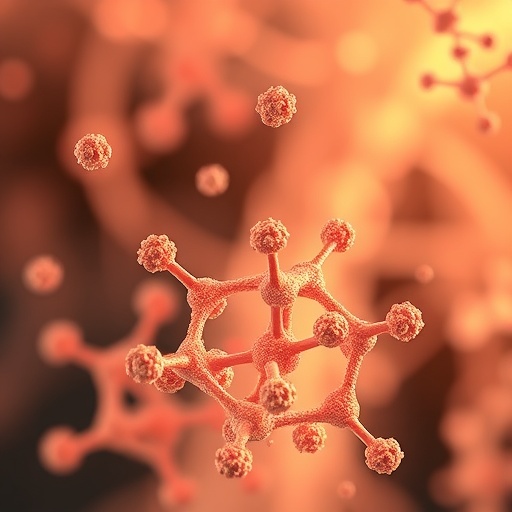In a groundbreaking advancement for oncology and biochemical research, scientists have isolated and characterized novel thermostable enzyme isoforms capable of continuous monocomponent superoxide radical production directly from human postoperative serous fluids. This innovative study opens new pathways to harnessing reactive oxygen species for targeted cancer therapy, especially in the critical postoperative period, where the balance between eradicating residual tumor cells and promoting healing is paramount.
Free radicals, particularly superoxide radicals (O₂⁻), have long been recognized for their dualistic roles in biological systems. While their overproduction is implicated in the pathogenesis of chronic illnesses such as cancer, these reactive molecules are also instrumental in the mechanism of action of many chemotherapeutic agents. Exploiting this paradox, the latest research pushes the envelope by isolating enzymatic complexes from serous fluids of patients suffering from breast cancer, gastric cancer, and liver cirrhosis—the first time such thermostable enzymes are extracted from these bodily fluids.
The isolated enzyme complexes uniquely produce monocomponent superoxide radicals continuously under aerobic in vitro conditions, an attribute that is especially noteworthy given the typically transient and reactive nature of superoxide molecules. Detailed biochemical characterization revealed that these enzymes are intricate multi-component systems. They comprise flavin adenine dinucleotide (FAD), a protein moiety containing reduced nicotinamide adenine dinucleotide phosphate (NADPH), and trivalent iron ions (Fe(III)). This specific composition is critical for the enzyme’s stability and sustained catalytic activity.
Understanding the stability of these enzymes at elevated temperatures, or thermostability, is another hallmark of the study. Thermostability not only endows them with potential for clinical applications requiring rigorous conditions but also suggests their robustness in diverse biological environments. The continuous production of superoxide radicals by these enzymes, without rapid denaturation or loss of function, distinguishes them from known oxygen radical-producing systems.
At the molecular level, the mechanism of O₂⁻ production was elucidated, providing unprecedented insights into the electron transfer processes facilitated by these enzyme complexes. The interplay between FAD, NADPH, and iron ions orchestrates a steady reduction of molecular oxygen to superoxide, a process finely tuned to avoid the generation of other reactive oxygen species that could be deleterious to both target and surrounding cells.
The research team conducted extensive spectroscopic analyses to support their findings. Notably, characteristic optical absorption and fluorescence excitation spectra were recorded. These spectra serve as molecular fingerprints of the enzyme complexes, aiding in understanding their conformational dynamics and redox states during catalysis. Such detailed optical profiling is crucial for future efforts to engineer or optimize these enzymes for therapeutic use.
Quantifying the concentrations of monocomponent superoxide radicals generated by these enzyme systems was another pivotal aspect of this work. Using precise biochemical assays, the researchers determined superoxide levels in molar concentrations per milliliter specific to each type of serous fluid. These quantifications are critical for planning dosage and therapeutic windows in potential clinical applications.
One of the most exciting therapeutic implications of this discovery lies in the selective cytotoxicity of superoxide radicals towards cancer cells. By predetermining effective concentrations of superoxide that selectively induce apoptosis in malignant cells, this enzymatic system offers a promising adjunct or alternative to traditional chemotherapy, potentially minimizing side effects and improving patient outcomes.
Moreover, the study reveals a fascinating ancillary function of these O₂⁻-producing enzymes: their ability to oxidize adrenaline molecules. Given the involvement of elevated adrenaline levels in tumor progression and metastasis, this capacity could introduce a novel approach to modulate the tumor microenvironment and stress-related oncogenic signaling through biochemical means.
Future directions articulated by the research team include rigorous in vivo animal studies aimed at evaluating the efficacy of these enzyme isoforms in eliminating metastatic cells after surgery. The postoperative period is particularly critical, as residual cancer cells can contribute to recurrence. Enzymes that reliably produce cytotoxic superoxide radicals in this window might significantly bolster postoperative oncologic strategies.
This work also raises intriguing questions about the endogenous roles of these enzyme systems in normal physiology and pathology. Their presence in serous fluids suggests previously unrecognized biochemical pathways that may influence local tissue environments, inflammatory responses, and possibly innate tumor resistance mechanisms.
The patented universal method employed for enzyme isolation highlights a scalable and reproducible approach, essential for translating these findings from bench to bedside. Developing pharmaceutical formulations and delivery systems tailored to maintain enzyme stability and activity in patients remains a crucial next step.
In recapitulating the potential clinical impact, the authors underscore that these thermostable enzyme isoforms may transcend conventional therapies by offering a means to generate reactive oxygen species selectively and sustainably at tumor sites. Such precision medicine approaches could redefine treatment paradigms, especially for cancers with limited responsiveness to current modalities.
Beyond oncology, these findings could spur advancements across a spectrum of medical fields. The biochemical properties of these enzymes—continuous monocomponent superoxide production, thermostability, and multi-component architecture—present compelling opportunities for research in immunology, neurodegeneration, and metabolic disorders where oxidative stress plays a complex role.
In conclusion, the identification and characterization of these unique enzyme isoforms mark a seminal moment in the intersection of enzymology and cancer therapy. By leveraging the intrinsic biological activity of superoxide radicals in a controlled, targeted manner, this study charts a promising horizon for enhancing postoperative cancer care and potentially mitigating metastasis.
Subject of Research:
Isolation and characterization of thermostable enzyme isoforms producing monocomponent superoxide radicals from human postoperative serous fluids and their therapeutic potential in oncology.
Article Title:
Thermostable enzyme isoforms, continuously producing monocomponent superoxide radicals, from human postoperative serous fluids: isolation and properties.
Article References:
Simonyan, R.M., Babayan, M.A., Yekmalyan, H.H. et al. Thermostable enzyme isoforms, continuously producing monocomponent superoxide radicals, from human postoperative serous fluids: isolation and properties. BMC Cancer 25, 1555 (2025). https://doi.org/10.1186/s12885-025-14372-w
Image Credits: Scienmag.com
DOI: https://doi.org/10.1186/s12885-025-14372-w




